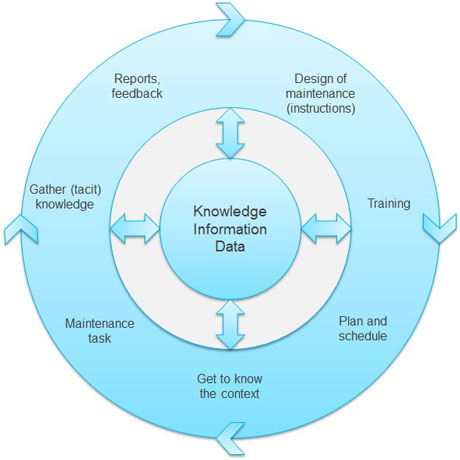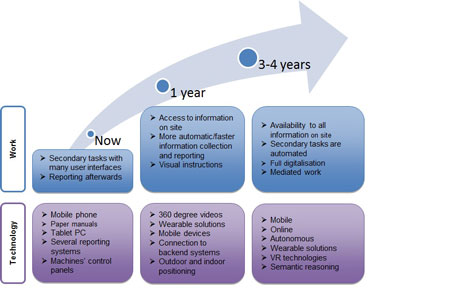by Eija Kaasinen, Susanna Aromaa and Ville Rauhala
One particularly promising application field for augmented reality (AR) is maintenance work. AR can provide field service personnel with easy access to situationally relevant information that supports their work. Several demos and proofs of concept have previously been presented. We propose that AR has a lot of potential, especially in gathering and sharing tacit knowledge. Successful solutions are based on a thorough understanding of the maintenance work and the associated knowledge sharing requirements.
The FIMECC S-STEP programme by Finnish Metals and Engineering Competence Cluster (FIMECC) is developing smart technologies for lifecycle performance, utilizing the possibilities of industrial internet and service business. One of the four projects of the programme focuses on knowledge sharing solutions for field personnel. In global service business, tacit knowledge, communicated person-to-person, is becoming less accessible owing to multivendor global services, employee turnover and age structure. Our project will utilize Augmented Reality (AR) based interaction tools to gather and to provide easy access to situationally relevant knowledge. This will radically improve service quality, work satisfaction, productivity and risk reduction. The planned outcomes of the project include work practices, user interaction solutions and data management solutions with which knowledge can be easily gathered, interpreted, built, stored, retrieved, shared and utilized in service operations.
The project involves FIMECC companies with their own business cases: Bronto Skylift, KONE, Konecranes and Wärtsilä, companies providing enabling technologies: 3D Studio Blomberg, Ixonos and Mevea as well as research organizations: VTT Technical Research Centre of Finland Ltd (leader), Aalto University, University of Tampere, Technical University of Tampere, Lapland University of Applied Science and Lappeenranta University of Technology.
Various Internet of Things (IoT) solutions provide real-time information from the maintenance targets. A lot of knowledge that supports service operations exists as tacit knowledge of the most experienced senior personnel. The work of maintenance personnel, assisted by AR solutions, can be supported by both IoT information and human tacit knowledge. Successful solutions provide situationally relevant information with appropriate modalities. Recent advances in both hardware quality and pricing enable the adoption of powerful AR and multimodal technologies on lightweight yet powerful mobile and wearable devices. Also, the related 3D tracking technologies, sensors and depth cameras allow implementation of multimodal AR even in challenging industrial environments. These solutions enable effortless or even automatic gathering of knowledge while expert maintenance persons are working, utilizing video and audio recordings complemented with text or speech. Mobile devices and AR glasses provide easy access to situationally relevant knowledge to support ongoing maintenance tasks of novice maintenance persons.
In the near future maintenance work will undergo a major transition because AR will affect most sub tasks of maintenance work as illustrated in Figure 1. Ideally, all required information will be available for the maintenance worker at any time, reporting will be automatic and the work will become more technology-mediated and digital [1]. Maintenance work places high demands on the interaction tools, which help to gather and provide information without disturbing the maintenance task at hand.

Figure 1: Most sub tasks of maintenance work will benefit from access to situationally relevant knowledge.
Figure 2 illustrates some of our company cases of AR solutions for maintenance where AR is utilized to give information about the maintenance service object and instructions. With AR solutions the reporting and gathering of tacit knowledge will be done automatically during the maintenance work. This information can again be applied to improve maintenance activities and processes.

Figure 2: Examples of our first case studies: augmented reality gives information about the maintenance service object and instructions. The solutions are based on AR-glasses and gesture recognition. (Company cases from Konecranes and KONE).
Figure 3 shows our project’s roadmap of the foreseen changes in maintenance work through the use of AR solutions and other technology. Work and technology changes are described from the current situation to 3-4 years into the future.

Figure 3 Roadmap for maintenance work and enabling technologies.
Our future plans include implementing company specific AR solutions and evaluating them with field service personnel. The parallel company cases facilitate learning from one case to another. Based on user feedback from all the company cases we will then design second generation use cases that will already be mature enough for actual field use.
Link:
FIMECC S-STEP Programme: http://www.fimecc.com/content/s-step-smart-technologies-lifecycle-performance-0
Reference:
[1] S. Aromaa, A. Väätänen, I. Aaltonen, T. Heimonen: “A model for gathering and sharing knowledge in maintenance work”, in proc. of the 33rd Annual Conference of the European Association of Cognitive Ergonomics.
Please contact:
Eija Kaasinen
VTT Technical Research Centre of Finland Ltd.
Tel: +358405571005
E-mail:
Susanna Aromaa,
VTT Technical Research Centre of Finland Ltd.
E-mail:
Ville Rauhala,
Lapland University of Applied Sciences, Finland
E-mail:











